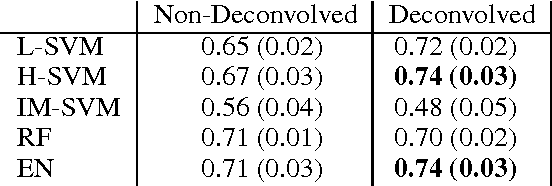Sparse Predictive Structure of Deconvolved Functional Brain Networks
Paper and Code
Oct 24, 2013
The functional and structural representation of the brain as a complex network is marked by the fact that the comparison of noisy and intrinsically correlated high-dimensional structures between experimental conditions or groups shuns typical mass univariate methods. Furthermore most network estimation methods cannot distinguish between real and spurious correlation arising from the convolution due to nodes' interaction, which thus introduces additional noise in the data. We propose a machine learning pipeline aimed at identifying multivariate differences between brain networks associated to different experimental conditions. The pipeline (1) leverages the deconvolved individual contribution of each edge and (2) maps the task into a sparse classification problem in order to construct the associated "sparse deconvolved predictive network", i.e., a graph with the same nodes of those compared but whose edge weights are defined by their relevance for out of sample predictions in classification. We present an application of the proposed method by decoding the covert attention direction (left or right) based on the single-trial functional connectivity matrix extracted from high-frequency magnetoencephalography (MEG) data. Our results demonstrate how network deconvolution matched with sparse classification methods outperforms typical approaches for MEG decoding.
 Add to Chrome
Add to Chrome Add to Firefox
Add to Firefox Add to Edge
Add to Edge